Bomberman World
miscellany

Planet Forest's depiction on the world selection screen is just a globe of Earth! The continents of Australia, Africa and South America are clearly visible as it rotates.
Manual oddities
The European manual's "Introduction to the Worlds" section is rather spottily laid out, with worlds, enemies and armour/Vehicle Characters arranged often completely out of order. It also provides literal translations of the planets' Japanese katakana and kanji names, one an onomatopoeic title and the other a description of its element, resulting in strangeness like "Whoosh Star" and "Ouch Star".
Merchant Bomber's name is untranslated in the Battle Game section, as "Bomber Akindo", and it also claims the name of Bagura's mecha is "Koji 1"; this must have been a preliminary name, as the only other instance of it is in a Comic Bom Bom preview.
Bomberman World was published in Europe by Sony Computer Entertainment, and later in North America by Atlus. The American version appears to be built off the European release, including some new quirks of its own.
Different fonts and licensing details. The European screen resolution is a little taller thanks to PAL video displays, and appears to fill in the space by giving Fire Bomber some terrible-looking feet.
The English releases have their respective publishers appear before the intro FMV; Sony Computer Entertainment use a basic black screen, while Atlus have a swish FMV of their own.
Like many PlayStation games, the "confirm" button is Circle in Japan and X internationally, while "cancel" is X in Japan and Triangle elsewhere.
The European version adds additional language support for French, German, Italian and Spanish, accessible on the main menu. This changes the text graphics for menus (see name changes below) but does not redub the spoken dialogue. The various language files still remain in the American version, but go unused.
Gameplay changes
In the European and American versions, Earth Bomber and Trent require one less hit to defeat.
Japanese/European - American
For whatever reason, the USA release completely changed all of the passwords! The European version shares the same passwords as the Japanese version. See the cheats and codes section for all the passwords to both versions.
Sound changes
The animated prologue features some brief lines of dialogue in Japan, with Bagura summoning the Dark Force Bombers and quickly briefing them. The ending animation has Bomberman emitting a quick "yatta!" as the Dark Star explodes. Both English versions remove these voice samples entirely, turning the story into an awkward drawn-out miming session.
The in-game voice samples were redubbed into English - twice! Once for the European release with British actors, and again for the Atlus release with an American cast. Some of the samples weren't dubbed in certain regions, leaving silence where those sounds would normally play - the European version does not announce Spark Bomber, for instance, likely due to its different names between languages.
"ボンバーマン!"
"スタート!"
" ? "
"ヤッホー!!"
" ? "
"ファイア!"
"ボムアップ!"
"スペシャル!"
"ゲームオーバー!"
"あ!"
"いで!"
"わ!"
" ? "
"Bomberman!"
"Start!"
" ? "
"Yeehaw!"
"Danger!"
"Fire!"
"Bomb Up!"
"Special!"
"Game over..."
"Oh!"
"Ouch!"
"Mistake!"
"Get armour!"
"Bomberman!"
"Start!"
"Darn!"
"Yeehaw!"
"Danger!"
"Fire!"
"Bomb Up!"
"Special!"
"Game over!"
"Oh!"
"Ouch!"
"No!"
"Armor!"
" ? "
"勝負だ!"
" ? "
"やった!"
"引き分け!"
"ボンバーマン!"
"ゲームスタート!"
"スパークボンバー!"
"ウイナー!"
"タイムオーバ!"
" ? "
" ? "
" ? "
" ? "
" ? "
"ラッキー!"
As is (usually) tradition with the names of unique Bombermen, the names of the Battle Game characters have their 'title' suffixed in Japan (Bomber Bishop), but have it as a prefix in English regions (Bishop Bomberman).
"しろボン"
"くろボン"
"あおボン"
"あかボン"
"みどりボン"
"ボンバーモンク"
"ボンバーピショッブ"
"ボンバーフェアリー"
"ボンバーヒーロー"
"ボンバーニンジャ"
"ボンバーアキンド"
"ボンバーウィッチ"
Japanese: "わっきゃー!俺様の大地を揺るがす力を知れぃ!"
/ "なんで俺様がギッタギッタなのだぎゃ?"
European: "See, I can crack the earth! Feel the power, Bomberman!"
/ "Why was I beaten so badly?"
American: "See, I can crack the earth! Feel my power, Bomberman!"
/ "Why was I beaten so badly?"
Japanese: "さっきの俺様のようにはいかないぎゃん!行けぇっ!トレントぉ!
"
/ "ぎゃー!"
European: "You have run out of luck! Go, Trento!"
/ "Whaa!"
American: "You have run out of luck! Let's go, Trento!"
/ "This can't be!"
Earth Bomber comes across as a manic son of a gun in Japan, just like he was in Bomberman Wars. The European version bills him as more of a cartoon villain, while the American voice attempts to be more sinister and weaselly.
Japanese: " ? "
/ " ? "
European: "Catch my cyclone power, Bomberman!"
/ "You'll be sorry!"
American: "Cyclone power!"
/ "You'll be sorry!"
Japanese: " ? "
/ "やぁー! 嘘!"
European: "You should not let your guard down! Go, Bassary!"
/ "Oh, this isn't happening!"
American: "Ha! I'm not done yet! Let's go, Bassary!"
/ "This isn't happening!"
Cyclone Bomber's ojou laugh is lost in translation, though the British voice manages to simulate the snotty noblewoman vibe. The American version might as well be Lani Minella's Rouge the Bat voice.
Japanese: " ? "
/ " ? "
European: "Hahaha! You'll be burnt, Bomberman!"
/ "I'll burn you bad, now!"
American: "Heh heh heh, you're gonna get burned, Bomberman!"
/ "You're gonna fry now!"
Japanese: " ? "
/ "も、燃える!"
European: "My fire hasn't died out. Go, Gangoron!"
/ "I'm dying!"
American: "My fire isn't out yet. Let's go, Gangoron!"
/ "It hurts!"
Banjo Ginga delivers one of his deep-voiced villain voices. The European version gives Fire Bomber a certain bombast, though the American version sounds like a dim-witted thug something straight out of Power Rangers.
Japanese: " ? "
/ " ? "
European: "Hahaha! You'll never defeat me, Bomberman!"
/ "Ouch!"
American: "Heeheehee, you'll never defeat me, Bomberman!"
/ "Ouch!"
Japanese: " ? "
/ "ぎゃー!"
European: "Hahahahaha! Can you bear the aqua power? Go, Ikaringer!"
/ "Augh!"
American: "Haha, can you withstand my power? Let's go, Ikaringer!"
/ "Ah!"
Show Hayami's Aqua Bomber gives the impression of a laughing-mad, conceited villain, while the English voices paint him as different varieties of slimy.
Japanese: " ? "
/ " ? "
European: "Well done, Bomberman. Welcome to my world."
/ "You can't defeat me!"
American: "Well done, Bomberman. Welcome to my world."
/ "You can't defeat me!"
Japanese: " ? "
/ " ? "
European: "The dark power is invincible! Give up, Bomberman!"
/ "The dark power will never die! I shall return!"
American: "The dark power is invincible! Give up, Bomberman!"
/ "The dark power will never die! I shall return!"
The European version matches the gruff old professor vibe of the Japanese voice pretty well. The American version ditches it in entirely and makes him spark in a low, modulated growl.
name changes
With the game available in six languages, there's a whole lot of names to go around! It's a good thing they're all extremely literal. The planet names were changed accordingly; see the Area pages for specifics on the Japanese names.
モリモリスター
ヒューヒュースター
アチアチスター
ブクブクスター
フラックスター
Planet Forest
Planet Wind
Planet Fire
Planet Ocean
Planet Black
Planéte Forêt
Planéte Vent
Planéte Feu
Planéte Océan
Planéte Noire
Waldplanet
Windplanet
Feuerplanet
Meeresplanet
Schwarzer Planet
Pianeta Foresta
Pianeta Vento
Pianeta Fuoco
Pianeta Oceano
Pianeta Oscuro
La Selva
El Viento
El Fuego
El Océano
Oscuridad
The Battle Game maps were also translated accordingly:
スタンダード
クルクルキャンディ
ジャングルトンネル
コロコロボン
ゴーゴートロッコ
ツルツルドカーン
カラクリドカン
ノロノロビューン
サラサラワープ
シーソーパーク
ブクブクボン
ポムショック
STANDARD
CANDY STORE
JUNGLE TUNNEL
BRICK CASTLE
VOLCANO
SLIPPY VALLEY
CHIMNEY BLAST
SLOW OR FAST
DESERT WARP
SEESAW PARK
UNDER THE SEA
BOMBER SHOCK
STANDARD
CONFISERIE
JUNGLE
CHATEAU
VOLCAN
VALLÉE GLISSANTE
CHEMINÉE BRISÉE
PARKING
DÉSERT
BALANÇOIRE
SOUS LA MER
SECOUSSE
STANDARD
SÜßWARENLADEN
DSCHUNGELTUNNEL
ZIEGELSCHLOß
VULKAN
EISTAL
KAMINBOMBEN
LANGS./SCHNELL?
WÜSTENTELEPORT
ABENTEUERPARK
UNTERM MEER
BOMBENSCHOCK
STANDARD
PASTICCERIA
GIUNGLA
CASTELLO
VULCANO
VAL DI GHIACCIO
CIMINIERA
PARCHEGGIO
DESERTO
ALTALENA A BILICO
ABISSI
BOMBARDAMENTO
ESTÁNDAR
KIOSKO
TÚNEL DE JUNGLA
CASTILLO
VOLCÁN
VALLE DE HIELO
CHIMENEA
PARKING
DESIERTO
PUENTE LEVADIZO
FONDO DEL MAR
TERREMOTO
The Spark Bomber mini-game saw a literal translation between regions; it retained its name in Spanish.





And lastly, the Challenge Game ranks.
だめボン
さるボン
みそボン
なみボン
うまボン
ぷろボン
かみボン
めいじん
たつじん
げきボン
WORST BOMBER
BAD BOMBER
BEGINNER BOMBER
AVERAGE BOMBER
DECENT BOMBER
PROFESSIONAL BOMBER
SUPER BOMBER
KING BOMBER
MASTER BOMBER
ULTIMATE BOMBER
LE PIRE BOMBER
MAUVAIS BOMBER
BOMBER DU DIMANHE
BOMBER MOYEN
BOMBER CONVENABLE
BOMBER PROFESSIONEL
SUPER BOMBER
THE KING!!
QUELLE MAITRISE
T'ES LE SUPRÊME DES BOMBERS
MIESER BOMBER
SCHLECHTER BOMBER
ANFÄNGER BOMBER
DURCHSCHNITT BOMBER
NICHT SCHLECHT!
PROFIBOMBER
SUPERBOMBER
KÖNIGSBOMBER
MEISTERBOMBER
ULTIMATIVER BOMBER
PEGGIOR BOMBAROLO
CATTIVO BOMBAROLO
PRINCIPIANTE BOMBAROLO
MEDIO BOMBAROLO
DECENTE BOMBAROLO
PROFESSIONISTA
SUPER BOMBAROLO
RE BOMBAROLO
MEAESTRO BOMBAROLO
SUPREMO BOMBAROLO
BOMBARDERO INÚTIL
MAL BOMBARDERO
BOMBARDERO PRINCIPIANTE
BOMBARDERO REGULAR
BOMBARDERO DECENTE
BOMBARDERO PROFESIONAL
SUPER BOMBARDERO
EL REY DE LOS BOMBARDERO
EL MAESTRO DE LOS BOMBARDERO
EL MÁS BOMBARDERO
Bomberman Collection
All of the American changes are retained in the English release of Bomberman Collection.

The title screen is edited to remove Atlus' publishing credit, and pressing Start will skip straight to the Game Mode menu; this is because the compilation's wrapper has its own control setup screen, so the in-game options are unnecessary.
early footage
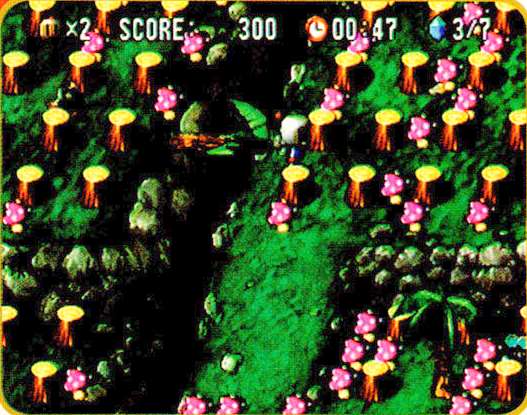
From Electronic Gaming Monthly issue 101. The crystal counter has a maximum of 7; you only ever need a maximum of 6 in Normal Game.
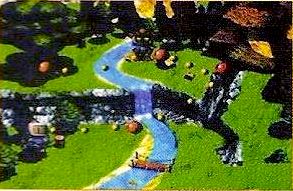
This screenshot from Plug n Play Games No.2 shows an early render of Morimori Star, featuring different or missing trees, and a prominent cliffside that overlaps the ravine.
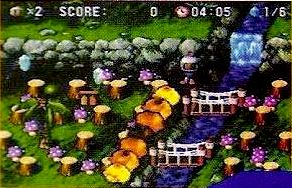
From the same magazine. There's over 4 minutes on the clock, and some object where the rock in 1-2 normally is.

The February 1998 issue of Comic Bom Bom features a stage that's completely missing from the final game! It's a large stage with sprawling mine cart tracks; given the game's VRAM issues (see "Armor oddities"), it's unlikely a stage this large could be made and is probably a mockup.


From Computer & Video Games issue 195. The Slippy Valley battle arena is shown with ice cubes hard blocks. The same issue also shows the Normal Game's HUD in Challenge Game.
unused graphics

From ST2_0.RC, a small floating piece of earth. Likely intended as a background detail for Wind Planet.
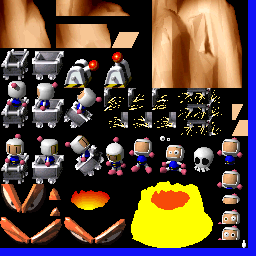
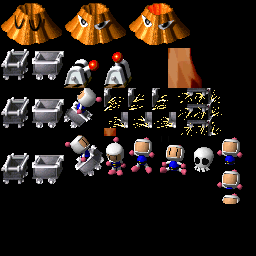
Normal Game / Battle Game
Files ST3_0.RC and BT05.RC contain graphics used in the volcano tileset, seen in Planet Fire in Normal Game and the Volcano arena in Battle Game. The Battle Game version has some slight differences in the minecart's shading, duller colours on the switch, and Bomberman's shocked expression isn't drawn on yet. It also has a sprite for a mini volcano; a larger volcano is baked into Area 3-1's background, though a scribbled yellow outline still exists in its graphic set.

ST3_0.RC also contains these small graphics; what appears to be a flatter hard block, some sort of flattened spout, and larger sprites for the volcano's meteors.

ST4_0.RC has unused objects from Bukubuku Star: a spring-loaded floor tile; a switch (looking more preliminary than even the one in BT05.RC); a wireframe cube; and a "TSUKAMO" signature likely from 3D designer Katsuyuki Tsukamoto.







The ST5_0.RC file contains assets for Black Star, including a bunch of stuff that's not seen in Normal Game or Battle Game. From left to right: A different, bulkier design for the electricity pylons; a smaller design for the satellite switch; horizontal and vertical buzzsaws; machinery behind a mesh fence; red and yellow arrow tiles; a blue tube; a computer tower; and a ladder.


An ice cube and alternate floating platform can be found in BT06.RC. The ice cube is a leftover from an early design (see early footage).

From BT07.RC, what appears to be an alternate set of pipe graphics for Battle Game's Chimney Blast arena, depicted as trapdoors. Likely changed to make them stand out against the brown and tan environment.
Among the battle victory results graphics in the the BWIN.RC file is a mugshot of Shigeki Fujiwara, the game designer of Bomberman World and many other titles. This photo originates from page 10 of Bomberman Maniax.
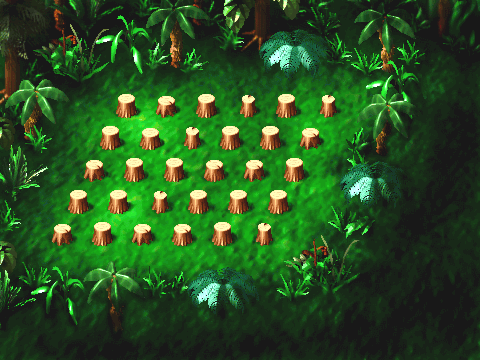
In the SAMPL.RC file is a graphic of a pre-assembled battle arena in the forest tileset (hard blocks are typically stored as sprites and laid on top of the blank backdrop). It features a wider variety of graphics than the forest environments in-game, with three different types of tree stump hard block and a unique turquoise fern.
unused sounds
In the SE6.BIN file is a sound file called GA131_11 (or named "SE6_00016" when extracted with PSound), found among the sound effects and voice samples used for the final fight with Bagura. This sample is unused and goes untouched in the English versions; it is not replaced with a dubbed version. It would almost certainly be used when God Header transforms into God Bomber, but Bagura is otherwise silent during the animation.
Armor oddities
Not necessarily unused, but the various Armor partners can actually be be carried into other stages with a bit of level-warping, and can fully interact with their objects and enemies. Normally upon beating a Dark Force Bomber you are forced into the second boss stage, but locking the stage select value will allow you to carry them into any other stage.

Teebo in Area 1-4
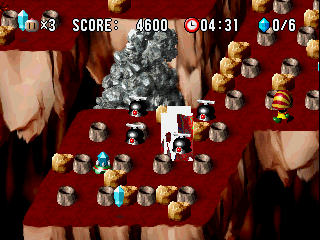
Nyanjrio in Area 3-2
Their graphics are only loaded in the boss stages, meaning they show up as blocks of garbled background tiles in any other stage. They do not have graphics for unique animations like riding the minecart or teleporting, but are otherwise fully functional. The likes of Teebo's jumping ability are useable, showing it's capable of leaping over soft blocks, hard blocks and bombs, something it otherwise has little use for in its one boss fight!

Teebo in a glitched Area 2-3
Taking a partner into another world will replace it with that world's 'designated' armour - Teebo can only be used in World 1, Rick in World 4, and so forth. You can circumvent this to some degree by setting the stage select value higher than it's intended to go (setting it to "7" while in Forest Planet will take you to Area 2-3 of Wind Planet, seen above). This will result in corrupted graphics and even incorrect objects loaded, rendering the level non-functional - in the above screenshot there are immobile bridges where there should be floating platforms!

An example of what the PlayStation's VRAM stores during gameplay- in this case, Area 1-3.
It's likely the ability to take Armors between stages was dropped for VRAM concerns - the game loads a universal graphics file for Bomberman's sprites and items, as well as a separate file for every stage in the game. Once you factor in backgrounds, enemies and level-specific animations, there wouldn't be any room for the big armour buddy sprites!
| RETURN TO GAME INDEX |
RETURN TO MASTER GAME LIST |
RETURN TO HOME PAGE |
| page last modified: 28/10/2019 | ||